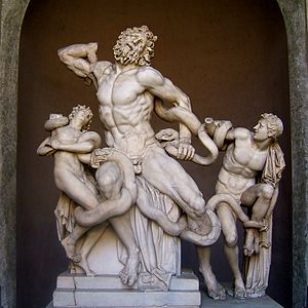Occidental Mythology

The Laocoon, Wikimedia Commons
Much of the complexity and vitality of the Occidental heritage must be attributed to the conflicting claims – both of which are accepted – on the one hand, of the advocates of what is offered as the word of God, and, on the other, of the rational individual. The legacy of the Bronze Age supplied many of the basic motifs of Occidental, as well as of Oriental, mythological thought.
Going back to about 7500 B.C., in the high, protected mountain valleys of Asia Minor, Syria, northern Iraq, and Iran, the arts of agriculture and stock breeding were developed, producing an epochal mutation in both the character of human existence and its potentialities for development. A second epochal mutation occurred around 3500 B.C., when in the river land of Mesopotamia the fundamental arts of all civilization were invented: writing, mathematics, monumental architecture, systematic scientific observation (of the heavens), temple worship, and the art of government. The knowledge and application of these reached Egypt with the first pharaos of Dynasty I, about 2850 B.C., Crete and the Indus Valley about 2500 B.C., China about 1500 B.C. and to Mexico and Peru in the period 1000 – 500 B.C.
In the neolithic village stage of this development, the focal figure of all mythology and worship was the bountiful goddess Earth, as the mother and nourisher of life and receiver of the dead for rebirth. Toward the close of the Bronze Age and, more strongly, with the dawn of the Iron Age (about 1250 B.C. in the Levant), the old cosmology and mythologies of the goddess mother were radically transformed, reinterpreted, and in large measure suppressed, by those suddenly intrusive patriarchal warrior tribesmen whose traditions have come down to us chiefly in the Old and New Testaments and in the myths of Greece.
These intrusive warrior waves came from two areas: the Syro-Arab deserts were the source as regards the Semites, and the broad plains of Europe and southern Russia as regards the Hellenic-Aryan stems. In his treatment of this evolution, Joseph Campbell distinguishes between the following phases:
· The Age of the Goddess; divided into two themes: The Serpent’s Bride and The Consort of the Bull.
· The Age of the Heroes; divided into the themes Gods and Heroes of the Levant (1500 - 500 B.C.), and Gods and Heroes of the
European West(1500 – 500 B.C.).
· The Age of the Great Classics; divided into The Persian Period (539 – 331 B.C.), Hellenism (331 B.C. – 324 A.D.) and
Great Rome (500 B.C. – 500 A.D.).
· The Age of the Great Beliefs; divided into The Cross and the Crescent, and Europe Resurgent.
Going back to about 7500 B.C., in the high, protected mountain valleys of Asia Minor, Syria, northern Iraq, and Iran, the arts of agriculture and stock breeding were developed, producing an epochal mutation in both the character of human existence and its potentialities for development. A second epochal mutation occurred around 3500 B.C., when in the river land of Mesopotamia the fundamental arts of all civilization were invented: writing, mathematics, monumental architecture, systematic scientific observation (of the heavens), temple worship, and the art of government. The knowledge and application of these reached Egypt with the first pharaos of Dynasty I, about 2850 B.C., Crete and the Indus Valley about 2500 B.C., China about 1500 B.C. and to Mexico and Peru in the period 1000 – 500 B.C.
In the neolithic village stage of this development, the focal figure of all mythology and worship was the bountiful goddess Earth, as the mother and nourisher of life and receiver of the dead for rebirth. Toward the close of the Bronze Age and, more strongly, with the dawn of the Iron Age (about 1250 B.C. in the Levant), the old cosmology and mythologies of the goddess mother were radically transformed, reinterpreted, and in large measure suppressed, by those suddenly intrusive patriarchal warrior tribesmen whose traditions have come down to us chiefly in the Old and New Testaments and in the myths of Greece.
These intrusive warrior waves came from two areas: the Syro-Arab deserts were the source as regards the Semites, and the broad plains of Europe and southern Russia as regards the Hellenic-Aryan stems. In his treatment of this evolution, Joseph Campbell distinguishes between the following phases:
· The Age of the Goddess; divided into two themes: The Serpent’s Bride and The Consort of the Bull.
· The Age of the Heroes; divided into the themes Gods and Heroes of the Levant (1500 - 500 B.C.), and Gods and Heroes of the
European West(1500 – 500 B.C.).
· The Age of the Great Classics; divided into The Persian Period (539 – 331 B.C.), Hellenism (331 B.C. – 324 A.D.) and
Great Rome (500 B.C. – 500 A.D.).
· The Age of the Great Beliefs; divided into The Cross and the Crescent, and Europe Resurgent.